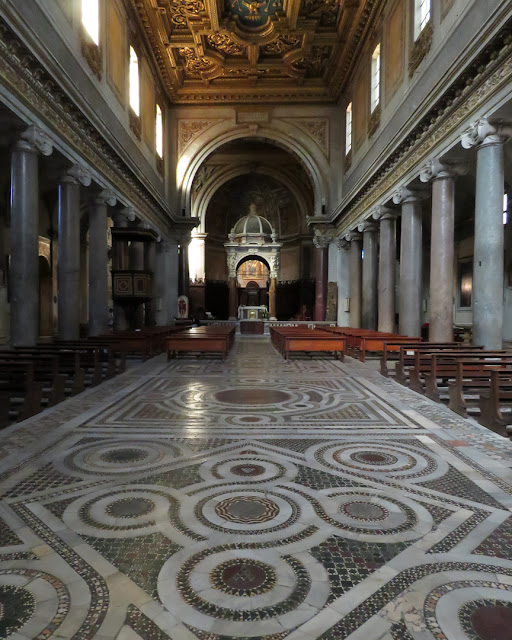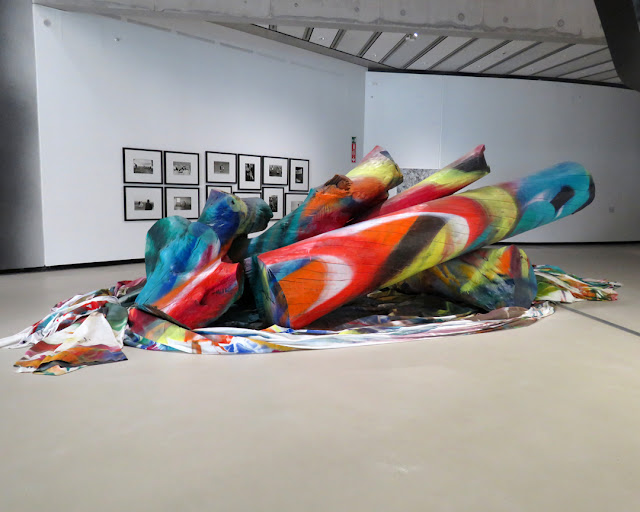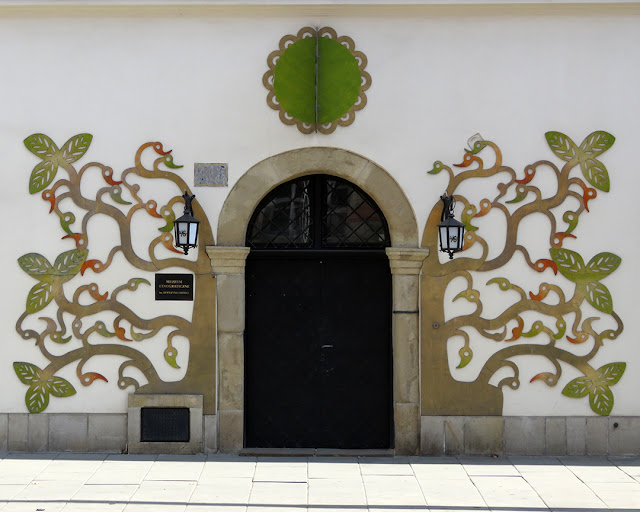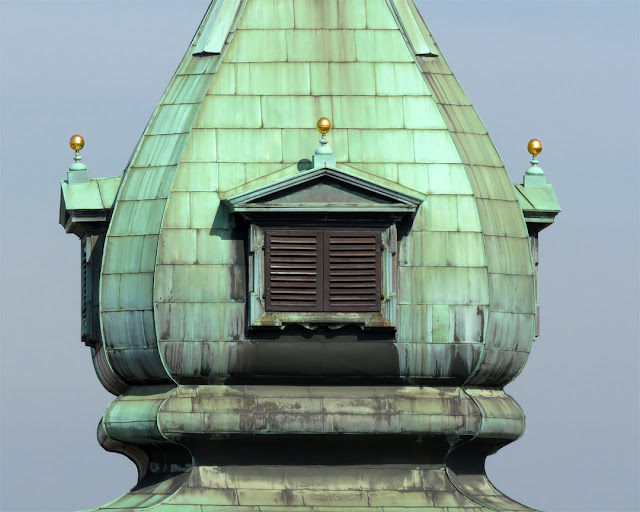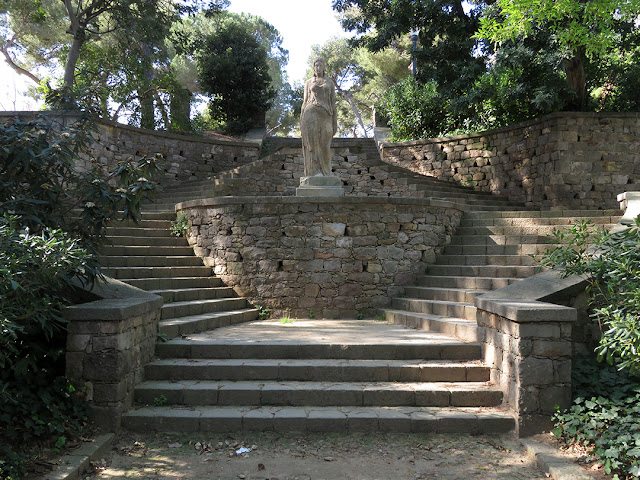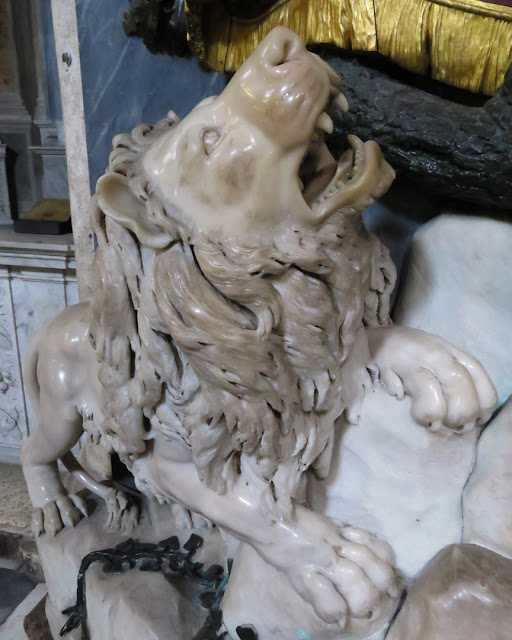Monday, February 28, 2022
San Crisogono
Basilica di San Crisogono (Basilica of Saint Chrysogonus)
Piazza Sidney Sonnino
Rome, September 2019
“San Crisogono is a church in Rome (rione Trastevere) dedicated to the martyr Saint Chrysogonus. It was one of the tituli, the first parish churches of Rome, and was probably built in the 4th century under Pope Sylvester I (314–335), rebuilt in the 12th century by John of Crema, and again by Giovanni Battista Soria, funded by Scipione Borghese, in the early 17th century. The area beneath the sacristy was investigated by Fr. L. Manfredini and Fr. C. Piccolini in 1907. They found remains of the first church (see below). After they had made this discovery, the area was excavated and studied. The church is served by Trinitarians. Among the previous Cardinal Priests was Vincenzo Gioacchino Raffaele Luigi Pecci (1853–1878), elected Pope Leo XIII.” (San Crisogono, Wikipedia)
Sunday, February 27, 2022
Saturday, February 26, 2022
Friday, February 25, 2022
Palazzo della Carovana
Palazzo della Carovana (also Palazzo dei Cavalieri)
Piazza dei Cavalieri (Knights’ Square)
Pisa, September 2020
“Palazzo della Carovana (also Palazzo dei Cavalieri) is a palace in Knights' Square, Pisa, Italy, presently housing the main building of the Scuola Normale Superiore di Pisa. It was built in 1562–1564 by Giorgio Vasari for the headquarters of the Knights of St. Stephen, as a renovation of the already existing Palazzo degli Anziani (Palace of the Elders). The name, meaning ‘Palace of the Convoy’, derives from the three-year period undertaken by the initiates of the Order for their training, called ‘la Carovana’. The façade is characterized by a complex scheme with sgraffiti representing allegorical figures and zodiacal signs, designed by Vasari himself and sculpted by Tommaso di Battista del Verrocchio and Alessandro Forzori, coupled to busts and marble crests. The current paintings date however to the 19th-20th centuries. Amongst the sculptures are the Medici Coat of Arms and that of the Knights, flanked by the allegories of Religion and Justice by Stoldo Lorenzi (1563). The upper gallery of busts of the Grand Dukes of Tuscany (who were all also the Grand Masters of the Order) were added in the late 16th-early 18th centuries, sculpted by Ridolfo Sirigatti, Pietro Tacca and Giovan Battista Foggini. Giusti coat of arms found at palazzo della carovana.The double-ramp staircase was remade in 1821. The rear area is a modern addition (1928–1930) for the Scuola Normale Superiore di Pisa. Some halls of the interior house 16th-century paintings.” (Palazzo della Carovana, Wikipedia)
Thursday, February 24, 2022
Kościół Nawiedzenia Najświętszej Marii Panny
Kościół Nawiedzenia Najświętszej Marii Panny (Church of the Visitation of the Blessed Virgin Mary)
ulica Przyrynek
Warsaw, September 2018
“The Church of the Visitation of the Most Blessed Virgin Mary (Polish: Kościół Nawiedzenia Najświętszej Marii Panny), otherwise known as St. Mary's Church (Kościół Mariacki) is a church in Warsaw, Poland. It is one of oldest buildings and one of the few surviving examples of Gothic architecture in the city. It is located at ulica Przyrynek 2. St. Mary's Church stands on the site of an ancient pagan place of worship.[1] The church's foundation stone was laid by Janusz I the Old, Duke of Masovia and his wife, Danutė of Lithuania, in 1409. The church was consecrated in 1411. It has been modified, demolished and rebuilt several times. Originally it had one nave, was made of bricks, had a ceiling and an arch presbytery, before the end of the 15th century it was transformed into a three nave basilica.” (Church of the Visitation of the Blessed Virgin Mary, Wikipedia)
Wednesday, February 23, 2022
A López y López
A López y López (El Negro Domingo) by Venancio Vallmitjana, 1884
Replica made in the 1940s by Frederic Marès, removed in 2018
Plaça d'Antonio López (Now Plaça d’Idrissa Diallo i Correus)
Barcelona, March 2017
Tuesday, February 22, 2022
Invisible Man
Invisible Man by Yinka Shonibare, 2018
MAXXI - Museo nazionale delle arti del XXI secolo
(MAXXI - National Museum of 21st Century Art)
Via Guido Reni
Rome, September 2019
Monday, February 21, 2022
Kościół św. Wojciecha
Kościół św. Wojciecha (Church of St. Adalbert)
Rynek Główny
Stare Miasto (Old Town)
Kraków, September 2018
“The Church of St. Adalbert or the Church of St. Wojciech (Polish: Kościół św. Wojciecha), located on the intersection of the Main Market Square and Grodzka Street in Old Town, Kraków, is one of the oldest stone churches in Poland. Its almost 1000-year-old history goes back to the beginning of the Polish Romanesque architecture of the early Middle Ages. Throughout the early history of Kraków the Church of St. Wojciech was a place of worship first visited by merchants travelling from across Europe. It was a place where citizens and nobility would meet. The Church was built in the 11th century and named after the martyred missionary Saint Adalbert (Polish: św. Wojciech) whose body was bought back for its weight in gold from the pagan Prussia and placed in Gniezno Cathedral by Boleslaus I of Poland. The Church of St. Adalbert stands at the south-eastern corner of the biggest medieval market square in Europe,[1] demarcated in 1257. The place of worship preceded the Square by nearly a century. The interior of the church is cramped, relative to its larger exterior. The floor level is situated under the present level of the Square, which reflects the overlaying of the subsequent surfaces of the plaza with pavement originally adjusted to the two already existing churches (St. Wojciech/Adalbert and St. Mary's Basilica). The church was partially reconstructed in the Baroque style between 1611-1618.” (Church of St. Adalbert, Wikipedia)
Sunday, February 20, 2022
Icona Point
Icona Point by Stockwool, 2008
Warton Road, Stratford
London, September 2014
“With a brief to deliver a high-quality, landmark building and drive the long-term regeneration of Stratford, Icona Point transforms a derelict site overlooking the Olympic Park into a mixed use scheme delivering 249 apartments together with commercial space in an 18 storey tower and two blocks of seven and four storeys. Led by a detailed urban analysis of the emerging townscape, the scheme was designed with a bold elliptical shape and clad with a brightly coloured façade to cement its prominent status. A central landscaped courtyard connects the blocks and encourages an integrated community and a new walkway extends through to the river frontage. The external envelope of steel and glass balconies, aluminium panels and distinctive fins were prefabricated and their installation completed without scaffolding.” (Icona Point, Stockwool)
Saturday, February 19, 2022
Santa Caterina d'Alessandria
Santa Caterina d'Alessandria
Piazza Santa Caterina
Pisa, September 2020
“Santa Caterina d'Alessandria is a Gothic-style, Roman Catholic church in Pisa, region of Tuscany, Italy. It is mentioned for the first time in 1211, then associated with a hospital. The current edifice was built between 1251 and 1300, commissioned by Saint Dominic himself, and entrusted to the friars of his order. The façade (completed in 1326) has a pointed shape with white and grey marble, with, in the upper section, two order of small Gothic loggias and a central rose window. The interior, after a fire in 1651, is on a single large hall. Renovated in the 18th century, it houses works by Lippo Memmi (Triumph of St Thomas, 1323), Fra Bartolomeo (Madonna with Sts Peter and Paul, 1511), Santi di Tito, Aurelio Lomi (Martyrdom of St Catherine), Raffaello Vanni, Pietro Dandini (all 16th-17th centuries) and marble sculptures by Andrea Pisano (Tomb of Archbishop Simone Saltarelli, 1343) and his son Nino Pisano (Annunciation, 1368). Also notable is the tomb of Gherardo Compagni, decorated with a late 16th-century ‘Pietà’ statue. The wooden pulpit from the 17th century, according to the tradition, was that from which St Thomas Acquinas preached.” (Santa Caterina, Wikipedia)
Friday, February 18, 2022
Fontanna Jasia Rybaka
Fontanna Jasia Rybaka (Fisherman's fountain) by Stanisław Szwechowicz, 1998
ulica Bohaterów Monte Cassino
Sopot, September 2018
Thursday, February 17, 2022
Antoni Rovira i Trias
Antoni Rovira i Trias by Joaquim Camps, 1990
Plaça de Rovira i Trias
Barcelona, March 2017
“Antoni Rovira i Trias (1816 in Barcelona – 1889 in Barcelona) was a Catalan architect, urban planner and founder of several associations, among them Societat Filomàtica de Barcelona. He is known as the architect of several buildings in Barcelona, among them the markets of Barceloneta (1873), La Concepció (1885; on career d'Aragó), El Born (1876) and Sant Antoni (1879). He is also responsible for the Passatge del Comerç (1855), Teatre Circ Barcelonès (1853) and the construction of the loggia of Palau Moja (1856) and, vital to the development of the city, the demolition of the Ciutadella, the 18th-century military citadel. His radial urban plan for Barcelona, under the name Le tracé d’une ville est oeuvre du temps plutôt que d’architecte rivalled with Ildefons Cerdà's, and won the 1859 municipal contest by city council's decree, but the central Spanish government in Madrid favoured Cerdà's over his, and construction started the following year. Eventually, however, Cerdà's plan would remain unfulfilled. Rovira's plan, and to a large degree himself too, were long forgotten until recently, when a book was published focusing on Rovira's egalitarian approach to urban planning, and small but meaningful details for which he was responsible.” (Antoni Rovira i Trias, Wikipedia)
Wednesday, February 16, 2022
Ingres Wood Seven
Ingres Wood Seven by Katharina Grosse, 2018
MAXXI - Museo nazionale delle arti del XXI secolo
(MAXXI - National Museum of 21st Century Art)
Via Guido Reni
Rome, September 2019
Tuesday, February 15, 2022
Ignacy Jan Paderewski
Pomnik Ignacego Jana Paderewskiego (Monument of Ignacy Jan Paderewski) by Michał Kamieński, 1978
Park Ujazdowski
Warsaw, September 2018
“The monument to Ignacy Jan Paderewski is located in Warsaw's Ujazdowski Park. Born in Kuryłówka in 1860, Paderewski is fondly remembered as a politician, patriot and musician. Having entered the Warsaw Conservatorium at the age of 12 he worked as a piano tutor after graduation. The death of his wife, just a year after they married, spurred him to commit his life to music and in 1887 he made his public debut in Vienna. His talent was obvious and his growing popularity saw him storm both Europe and the States, not just as a pianist, but a masterful composer as well. He was based in Paris during WWI and it was during this time he became actively involved in politics, becoming spokesman for the Polish National Committee. With the end of the war he sought a return to his homeland where, having played a key role in the Wielkopolska Uprising (which saw Poznań merged into the newly reformed Polish state), he was elected Poland’s third ever prime minister. It was he who signed for Poland’s part in the 1919 Treaty of Versailles, though his fall from grace was just around the corner. Many thought he had sold Poland short and in the face of growing public discontent he resigned from office in December 1919. A short stint as Poland’s representative in the League of Nations followed before he opted to resume his musical career. Aside from being a skilled musician, the mop haired Paderewski was also a popular public speaker, known for his devastating wit. One anecdote recalls him being introduced to a polo player with the words: ‘You are both leaders in your spheres, though the spheres are very different’. Not one to miss a beat Paderewski deadpanned ‘Not so very different, you are a dear soul who plays polo, and I am a poor Pole who plays solo’. During WWII he became an eminent figure in the London based exiled Polish Parliament, though died in 1941 with the country of his birth still under occupation.” (Ignacy Jan Paderewski Monument, In Your pocket)
Monday, February 14, 2022
Helter Skelter and Orbit
Helter Skelter slide and ArcelorMittal Orbit
Queen Elizabeth Olympic Park, Stratford
London, September 2016
“Orbit is described as ‘designed by Anish Kapoor and Cecil Balmond’. Kapoor is a Turner Prize winning sculptor, while Balmond is one of the world's leading designers. According to Kapoor, both men are ‘interested in a place where architecture meets sculpture’ and ‘the way that form and geometry give rise to structure’. Kapoor and Balmond stated that their interests have blurred and crossed over into each other's fields since they first began working together in 2002 on Kapoor's Marsyas installation in the Turbine Hall of the Tate Modern. As well as Orbit, in 2010 Kapoor and Balmond were also working on the Tees Valley Giants, a public art project in northern England. The sculpture was engineered by the Global engineer Arup, who developed the overall geometry, structural design and the building services including the lighting displayed extensively during the Olympic games. Architectural input by Kathryn Findlay (Ushida Findlay Architects, as a sub-consultant to Arup) made the sculpture into a functional building, for example designing the staircase.” (ArcelorMittal Orbit, Wikipedia)
Sunday, February 13, 2022
San Giuseppe
Bell tower of San Giuseppe
Via San Giuseppe
Pisa, September 2020
“Founded in 1530, this church, belonging to the Gesuate sisters of Lucca, was consecrated in 1572. It was the first building of a convent completed in 1534. The building was completely restructured and greatly modified Between 1707 and 1710 under the direction of Giuseppe and Francesco Melani. The plastered façade is flanked by pilasters culminating in Corinthian capitals, supporting a wide pediment, below which is a large window framed in marble above the doorway, it too framed in marble. Two marble plaques record privileges and honours conferred on the Compagnia del Crocione, and a third recalls restoration work carried out in 1895. A new bell tower was erected in 1710; square in shape, it is built in brick with a gallery in ‘pietra serena’.” (Church of St. Joseph, Pisa Tours)
Saturday, February 12, 2022
Dom Esterki
Dom Esterki
Muzeum Etnograficzne (Ethnographic Museum)
ulica Krakowska, Kazimierz
Kraków, September 2018
“The Seweryn Udziela Ethnographic Museum of Kraków (Polish: Muzeum Etnograficzne im. Seweryna Udzieli w Krakowie) is a museum in Kazimierz, Kraków, Poland. It was established in 1902. The plans for the establishment of the Ethnographic Museum began in 1902 and were related to the exhibition on folk art from the collection of Seweryn Udziela, organized by the Polish Applied Arts Society. The National Museum in 1904 created an ethnographic department and a permanent ethnographic exposition in the Cloth Hall was opened. There were collections of, among others, Seweryn Udziela, Stanisław Witkiewicz, and Tadeusz Estreicher. In 1910, the Society of the Ethnographic Museum was founded, which took over the collection from the National Museum. In 1911 a separate branch was established at Studencka St., with Seweryn Udziela as its director. A year later, the collections were exported to Wawel. After World War II, the seat of the Ethnographic Museum changed its place to Plac Wolnica 1, and after some time also to 46 Krakowska Street. The main building is the former Town Hall of Kazimierski. The collection numbers over 80,000 monuments and is associated with Polish culture (folklore, art, everyday life ...) as well as with other cultures of Europe and the world.” (Ethnographic Museum of Kraków, Wikipedia)
Friday, February 11, 2022
MNAC
Museu Nacional d'Art de Catalunya
(National Art Museum of Catalonia)
Palau Nacional, Montjuïc
Barcelona, March 2017
“The Museu Nacional d'Art de Catalunya (National Art Museum of Catalonia), abbreviated as MNAC, is a museum of Catalan visual art located in Barcelona, Catalonia, Spain. Situated on Montjuïc hill at the end of Avinguda de la Reina Maria Cristina, near Pl Espanya, the museum is especially notable for its outstanding collection of romanesque church paintings, and for Catalan art and design from the late 19th and early 20th centuries, including modernisme and noucentisme. The museum is housed in the Palau Nacional, a huge, Italian-style building dating to 1929. The Palau Nacional, which has housed the Museu d'Art de Catalunya since 1934, was declared a national museum in 1990 under the Museums Law passed by the Catalan Government. That same year, a thorough renovation process was launched to refurbish the site, based on plans drawn up by the architects Gae Aulenti and Enric Steegmann, who were later joined in the undertaking by Josep Benedito. The Oval Hall was reopened in 1992 on the occasion of the Olympic Games, and the various collections were installed and opened over the period from 1995 (when the Romanesque Art section was reopened) to 2004. The Museu Nacional d'Art de Catalunya (Museu Nacional) was officially inaugurated on 16 December 2004. It is one of the largest museums in Spain.” (Museu Nacional d'Art de Catalunya, Wikipedia)
Thursday, February 10, 2022
Mareo Merz
Mareo Merz by Elisabetta Benassi, 2013
MAXXI - Museo nazionale delle arti del XXI secolo
(MAXXI - National Museum of 21st Century Art)
Via Guido Reni
Rome, September 2019
Wednesday, February 9, 2022
Złota Brama
Złota Brama (Golden Gate)
Seen from the Targ Węglowy
Gdańsk, September 2018
“The Golden Gate (Polish: Złota Brama, German: Langgasser Tor) is a historic Renaissance city gate in Gdańsk, Poland. It is located within the Royal Route, the most prominent part of the historic city center and is one of its most notable tourist attractions. It was created in 1612–14 in place of a 13th-century gothic gate, the Brama Długouliczna (Long Street Gate). It is located at one end of Ulica Długa (Long Lane), where, together with Brama Wyżynna (Highland Gate) and Wieża Więzienna (Prison Tower), it forms a part of the old city fortifications. It was designed by architect Abraham van den Blocke and was built by Jan Strakowski. The architectural style of the gate is Dutch mannerism. Next to it is the late-gothic building of the Brotherhood of St. George. Both sides of the gate have attiques, with figures symbolizing the qualities of the ideal citizen. They were designed in 1648 by Jeremias Falck (Polonus), and reconstructed in 1878 due to the originals being damaged by weathering over time. From the West side they represent (in Latin): Pax (Peace), Libertas (Freedom), Fortuna (Wealth) and Fama (Fame). From the East (Long Lane) side they are Concordia (Agreement), Iustitia (Justice), Pietas (Piety) and Prudentia (Prudency). The Latin inscription on the gates reads: Concordia res publicæ parvæ crescunt – discordia magnæ concidunt (In agreement small republics grow, because of disagreement great republics fall). The gate was largely destroyed by Soviet shelling in World War II, but was rebuilt in 1957. Although most artifacts of Germanness were eradicated after the city became part of the Polish People's Republic in 1945,[citation needed] an original German inscription on the gate was restored in the 1990s: Es müsse wohl gehen denen, die dich lieben. Es müsse Friede sein inwendig in deinen Mauern und Glück in deinen Palästen ("They shall prosper that love thee. Peace be within thy walls, and prosperity within thy palaces." – Psalm 122)” (Golden Gate, Wikipedia)
Tuesday, February 8, 2022
Teetering on the edge
“Teetering on the edge” by Ekta Ekta
White Post Lane, Hackney Wick
London, September 2014
“Glaring out from the brick wall of an old sweet factory on the edge of the Olympic site in east London, a furious face throws a toothy snarl across the canal. Half monkey, half skull, with a golden clothes peg for a nose, the creature has every reason to be angry. It is the work of local street art collective, the Burning Candy Crew, whose psychedelic scenes defined this industrial stretch of the River Lea Navigation, until they were mostly painted over in preparation for the 2012 Games. Now, on those very walls, the Olympic legacy's public art body has unveiled a series of new artworks – with not a local artist in sight. ‘It was a very deliberate decision,’ says Sarah Weir, former head of arts and cultural strategy for the Olympics, who now heads up the Legacy List charity that commissioned the work. ‘We unashamedly wanted to showcase the best international artists and transform this part of the canal into a destination for street art. We want it to have the same energy as somewhere like Camden – I hope people will come on boat tours to see the work.’ The four new works, which occupy prominent stretches of wall along both sides of the water, are by artists invited from Brazil and Sweden, Italy, Scotland and the Netherlands. On one building, a graphic black-and-white mural by Swedish artist Ekta Ekta climbs up to the eaves, a tangled pile of odds and ends that form a teetering Heath Robinson contraption. Beneath a bridge, a blue form by Brazilian painter Zezão unfurls like a tribal marking, recalling the looping shapes of cursive sanskrit script.” (Olympic legacy murals met with outrage by London street artists, The Guardian)
Monday, February 7, 2022
Arsenali medicei
Arsenali medicei (Medici Shipyards)
Lungarno Simonelli
Pisa, September 2020
“It was the idea of Cosimo I de’ Medici to build a shipyard in Pisa for the ships of the powerful Tuscan fleet. Already in operation around 1540, the new Medici shipyard launched the first galley entirely built by local workers in 1546. The Shipyard also witnessed the participation of Buontalenti, and was divided into eight aisles of an average length of 60 metres, 8 metres high, and about 10 metres wide. It was part of a project that intended to restore Pisa its ancient splendour that had been lost with the city’s surrender to the Florentines in 1509. The institution of the Order of Saint Stephen in 1562 and the transfer of the Medicinal Herbs Garden to the same area in 1563, were also part of this project. The competition of the shipyards of Livorno and Portoferraio, along with changes in maritime politics, however, soon decreed a slow and inexorable decline to the point that in the mid 18th century, under Lorraine rule, the premises were transformed into a horse stable for the Dragoon regiment. The restored area of the Shipyard today house several exhibitions that present part of the important finds, uncovered as of 1998, of relicts of boats and trappings found in the ancient Etruscan and Roman port area of Pisa, located near the Pisa-San Rossore railway station. This was an early port structure of the archaic age, with the remains of 19 ships of different tonnage (from the cargo ship to the river punt), and dating to a period between the late Hellenistic age and the late ancient age. These discoveries constitute a fundamental element in understanding the means of sea transportation in antiquity between the 5th century B.C. and the 5th century A.D. The Ships Museum is presently being set up in the Shipyards of the Knights of Saint Stephen, and will present the finds in a spectacular exhibition. Conceived as an "exhibition in progress", the Exhibition of Ships will indeed seek to make the visitor a participant in the various phases of the recovery works, from the archaeological excavation to the restoration laboratory to the final, but not definitive exhibition of the materials.” (Medici Shipyards, Scientific Itineraries in Tuscany)
Sunday, February 6, 2022
Clock Tower
Detail of the Wieża Zegarowa (Clock Tower)
Zamek Królewski (Royal Castle)
plac Zamkowy
Warsaw, September 2018
Saturday, February 5, 2022
Staircase by Forestier
Staircase by Jean-Claude Nicolas Forestier
Jardins de Laribal, Montjuïc
Barcelona, March 2017
“Jean-Claude Nicolas Forestier (9 January 1861 in Aix-les-Bains – 26 October 1930 in Paris) was a French landscape architect, who trained with Adolphe Alphand and became conservator of the promenades of Paris. He developed an arboretum at Vincennes and the gardens of the Champ-de-Mars below the Eiffel Tower. In 1925 he became Inspector of Gardens for the International Exhibition of Decorative Arts and undertook projects in the Americas.” (Jean-Claude Nicolas Forestier, Wikipedia)
Friday, February 4, 2022
Odescalchi lion
Detail of the monument of Maria Flaminia Odescalchi Chigi, 1772
Santa Maria del Popolo
Piazza del Popolo
Rome, May 2019
“The little monument clearly shows the influence of Bernini (in particular Bernini's monument to Maria Raggi in S. Maria sopra Minerva and the two gigantic coats of arms of Alexander VII over the organ in S. Maria del Popolo, with oak branches and leaves coming out the pipes) and the experience gained by Posi in designing ephemeral machines. In the lower part of the monument a lion (Odescalchi) is climbing a mountain (Chigi); to the right of the mountain one can see an incense burner (Odescalchi) and even the twists of the smoke.” (The Last Baroque Tomb, Rome Art Lover)
Thursday, February 3, 2022
Plac Bohaterów Getta
Some of the metal chairs, 2005
plac Bohaterów Getta (Ghetto Heroes Square)
Kraków, September 2018
“First plotted out in 1836, this public square just across the river from the Powstańców Śląskich bridge has had a turbulent history, with turns as a marketplace, horse stable, execution site, taxi rank and bus terminal over the years. During the time of the Kraków Ghetto it was at once the source of the residents’ greatest relief and also the scene of their greatest horrors and humiliation. As the ghetto’s largest open space, Plac Zgody was a place for people to socialise, relax and escape the oppressive overcrowding of the tenements. It was also the site of families being torn apart, mass deportations to the death camps, beatings and executions. Following deportations and the final liquidation of the ghetto, Plac Zgody was strewn with furniture, clothes, luggage and other belongings that the victims had been forced to abandon - this image would later inspire the redesign of the square. Though after the war the name of Plac Zgody was changed to Plac Bohaterów Getta (Ghetto Heroes Square) and a small monument was erected, the space’s historical significance never felt more pertinent than its post-war use as a public toilet or parking lot. Finally, after decades of neglect, Plac Bohaterów Getta was renovated in 2005, sparking significant controversy over the design. Laid out with 70 large well-spaced metal chairs meant to symbolise departure, as well as subsequent absence, the entire square has essentially been turned into an odd, but iconic memorial to the victims of the Kraków Ghetto. A place for candles and reflection was created in the former German guardhouse at the north end of the square, however the gesture rings hollow considering the space is always locked. During the war, Plac Bohaterów Getta 6 was the regular meeting point of the Jewish Combat Organisation (ŻOB), as noted by a plaque on the front of the building. Kraków’s Jewish underground resistance orchestrated acts of sabotage outside the ghetto, with their greatest success coming in December 1942 when a grenade detonated inside the Cyganeria Café – a popular meeting place for Nazi officers on ul. Szpitalnia - killing and wounding several Germans. Plac Bohaterów Getta 18 - on the south side of the square at the corner of ul. Targowa – was the site of Pankiewicz’s famous Apteka Pod Orłem, now a branch of the Kraków History Museum with exhibits depicting life in the ghetto. Every year on the Sunday following the March 14th liquidation of the ghetto, a remembrance parade honouring the victims sets off from Plac Bohaterów Getta to the Holocaust monument on the site of the former Płaszów camp.” (Plac Bohaterów Getta, In Your pocket)
Wednesday, February 2, 2022
Be Part of It
Southbank London Be Part of It poster
St Thomas' Hospital Garden
The Queen's Walk, Lambeth
London, September 2014
Tuesday, February 1, 2022
Lungarno Pacinotti
Lungarno Pacinotti
Seen from the Ponte di Mezzo
Pisa, September 2020
“Pisa, as well as Florence, is crossed by the Arno river. Pisan lungarnos, adorned with wonderful buildings and bridges survived the bombing during the second world war, are the most picturesque and famous places in Pisa, and among the most romantic for sure! The lungarnos host many hotels and residences, because of their central location they represent the ideal choice for tourists visiting the city. We propose you a walk through these amazing streets, where you can enjoy a wonderful view of the river and all that around it. We strongly recommend, according to the season, to try one of the delicious ice cream parlors on lungarnos or to taste a pastry sitting in the well known bakeries in Pisa. If you'd like to know better the past and the present of Pisa, the visit to lungarnos is essential. Lungarnos are the streets of the city that pass beside the river Arno. They are well known in Pisa for wonderful buildings that go along with the river bank until they reach the river outlet in Marina di Pisa. Few centuries ago lungarnos were the heart of the city center, and that's why wealthy families had chosen this area for their residences. They were completely reconstructed in 1871, which sadly destroyed many stairs and flights of steps that were characteristic of this area.” (Lungarnos of Pisa, About Pisa)
Subscribe to:
Posts (Atom)

